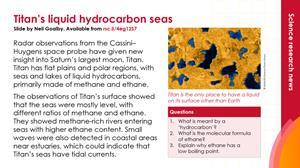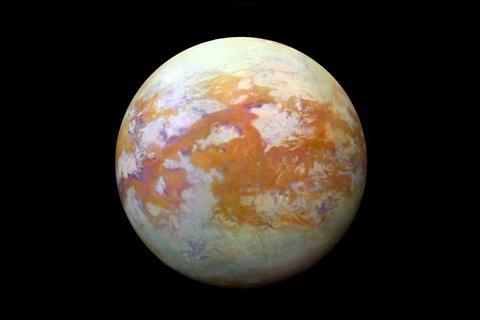Saturn’s largest moon attracts scientists seeking locations capable of harbouring extraterrestrial life
-

Download this
Use this story and the accompanying summary slide for a real-world context when studying alkanes, such as methane and ethane, with your 14–16 learners.
Download the story as MS Word or PDF and the summary slide as MS PowerPoint or PDF.
Scientists studying radar data collected by the Cassini–Huygens space research mission have discovered new variations in the composition of the three largest liquid hydrocarbon seas of Titan, Saturn’s largest moon.

Cassini was a Nasa-led mission that flew by Titan 127 times between 2004 and 2017. This moon is the only celestial body with liquid on its surface besides Earth. However, Titan’s liquid is not water but supercold methane and ethane, which are gases on Earth. These hydrocarbons form rivers, lakes, and seas on Titan, and even fall as rain.
Scientists are particularly interested in the possibility of life on Titan. Titan’s liquid hydrocarbons could potentially serve as solvents to support life. However, we still have lots to learn about Titan’s hydrocarbon composition and cycle.
Sea secrets scrutinised
Cassini carried a large suite of scientific instruments. For example, radars that bounced radio waves off Titan’s surface and reflected the returning signal back to Earth, which satellites received on the ground. A research team led by Valerio Poggiali at Cornell University has analysed this data. The data has provided new insights into the differences in chemical compositions between Titan’s three seas: Kraken Mare, Ligeia Mare and Punga Mare.
Valerio’s team found significant variations in the composition between the three seas, which they say are consistent with the seas having different methane to ethane ratios. The scientists also observed differences between the compositions of the estuaries compared to the open seas. They suggest this is due to methane-rich rivers entering seas with higher ethane contents, similarly to freshwater rivers flowing into salty oceans here on Earth. The team also detected small waves in coastal areas near estuaries, which could indicate that Titan’s seas have tidal currents.
They are still mining the huge trove of data collected by Cassini for further insights into Titan’s liquids. The next mission to study Titan’s chemistry up-close will be Dragonfly, Nasa’s drone-like mission scheduled to arrive at Saturn’s largest moon in 2034.
This article is adapted from Julia Robinson’s in Chemistry World.
Nina Notman
Reference
V Poggiali et al, Nat. Commun., 2024, 15, 5454 (doi.org/10.1038/s41467-024-49837-2)
Download
Summary slide with questions and the article for context when teaching 14–16 lessons on alkanes: rsc.li/3ZjbsfB
Downloads
Titan's hydrocarbon seas student sheet
Handout | PDF, Size 0.16 mbTitan's hydrocarbon seas student sheet
Handout | Word, Size 0.62 mbTitan's hydrocarbon seas summary slide
Presentation | PDF, Size 0.31 mbTitan's hydrocarbon seas summary slide
Presentation | PowerPoint, Size 0.49 mb














No comments yet